When it comes to designing the perfect kitchen light fixtures, one of the most important elements to consider is lighting. After all, what good is a beautifully designed kitchen if you can’t see your countertops or properly light your dining area? Kitchen light fixtures are not just functional—they can also set the mood, enhance the decor, and make the entire space more welcoming. In this guide, we will explore the various types of Kitchen Light,and kitchen tiles Fixtures, help you choose the right fixtures for your space, and give you tips on how to install and maintain them.
Why Kitchen Lighting is Crucial
Kitchen lighting is about more than just turning on a light switch. The right lighting can transform your cooking and dining experience. From providing task lighting to enhancing the atmosphere, each light fixture in your kitchen plays a vital role. Without proper lighting, you could find yourself squinting over a cutting board, spilling ingredients, or straining your eyes while trying to read a recipe. The kitchen is the heart of the home, and it deserves to be properly illuminated.
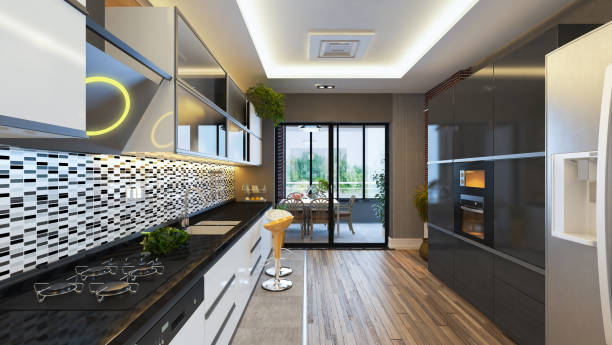
Types of Kitchen Lighting Fixtures
Not all kitchen lighting is the same. In fact, there are several types of lighting you can use to improve the functionality and style of your backsplash kitchen tiles. These include:
- Ceiling Lights
Ceiling lights are the standard fixture in most kitchens. They provide ambient lighting and help set the overall mood of the room. Depending on your kitchen layout, you might need one or more ceiling lights. - Pendant Lights
Pendant lights are a great choice for kitchens with islands or breakfast bars. These lights hang from the ceiling and offer both decorative flair and task lighting. - Recessed Lighting
Recessed lighting is built into the ceiling, making it a sleek and modern option. These lights are great for providing even, overhead lighting and can be placed in a grid pattern or strategically over work areas.
Understanding Different Light Types
In order to create the perfect lighting setup for your kitchen, it’s important to understand the three main types of lighting: ambient, task, and accent. Each of these types plays a different role in making your kitchen both functional and beautiful.
- Ambient Lighting
This is the general lighting that fills the room. It could come from ceiling lights or recessed lights and is essential for overall visibility. - Task Lighting
Task lighting is focused lighting for specific tasks, like chopping vegetables or reading recipes. Pendant lights or under-cabinet lighting are great examples of task lighting. - Accent Lighting
Accent lighting adds style to your kitchen and highlights particular features such as artwork or decorative glassware.
Choosing the Right Kitchen Lighting
Selecting the right kitchen light fixtures can be overwhelming, given the vast range of options. However, there are a few things to consider that will help narrow down your choices:
- Kitchen Size
If your kitchen is large, you might need multiple light sources to ensure proper coverage. Smaller kitchens can benefit from strategically placed lights that maximize efficiency. - Lighting Zones
Think about the different areas in your kitchen and the type of lighting each one needs. For example, your workstations may need bright task lighting, while the dining area could benefit from softer, more ambient lighting. - Style
Your lighting should complement the overall style of your kitchen. Modern kitchens often use sleek, minimalist designs, while traditional kitchens may incorporate more ornate fixtures like chandeliers.
Kitchen Lighting Styles
The style of your kitchen lighting is just as important as its functionality. Here are a few popular styles to consider:
- Modern Kitchen Lighting
If you prefer clean lines and minimalism, modern kitchen lighting fixtures are the way to go. Think of sleek pendant lights, recessed lighting, or LED strips that fit seamlessly into your decor. - Rustic Lighting
For a cozy, farmhouse vibe, rustic kitchen lighting features natural materials like wood and wrought iron. Chandeliers and vintage-inspired pendant lights are common in rustic kitchens. - Transitional Style
Transitional kitchen lighting blends traditional and modern elements. You might find a mix of sleek pendant lights and classic chandeliers, all with a clean, simple design.
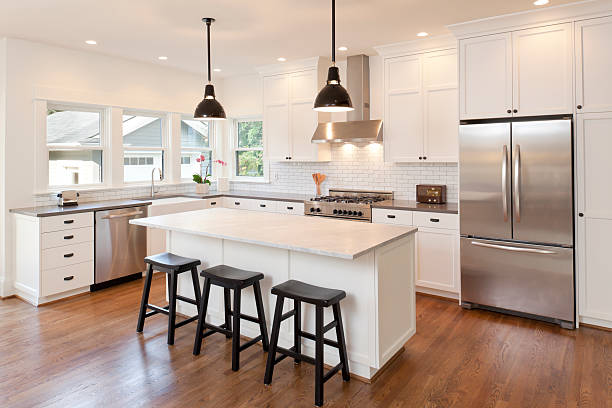
Task Lighting: A Kitchen Essential
When you’re preparing meals, task lighting is essential. Whether you’re chopping vegetables, washing dishes, or reading a recipe, you need adequate light to perform these tasks safely and efficiently. Below are some popular task lighting options:
- Under-Cabinet Lighting
This type of lighting is installed under kitchen cabinets to illuminate countertops. It’s perfect for when you need focused light while preparing meals. LED strips are a popular choice for under-cabinet lighting because they are energy-efficient and provide bright, even light. - Pendant Lights for Task Lighting
If your kitchen has a large island or breakfast bar, pendant lights can serve as both decorative and task lighting. These lights can be hung directly above work surfaces, providing focused light where you need it most.
Lighting for Your Kitchen Island
A kitchen island is often the focal point of the space, so it makes sense that you’d want to highlight it with the right lighting. Pendant lights are a great option for kitchen island lighting. They come in a variety of styles, from single pendant lights to a series of multiple pendants arranged in a row.
The Power of LED Kitchen Lights
LED kitchen lights have become increasingly popular due to their energy efficiency, long lifespan, and modern aesthetic. Unlike traditional incandescent or fluorescent lights, LEDs use less power, produce less heat, and can last for decades. If you’re looking to reduce your energy bills and minimize your environmental impact, LED kitchen lighting is a fantastic choice.
- Benefits of LED Lighting
- Energy Efficiency: LEDs use significantly less power than traditional bulbs.
- Long Lifespan: With an average lifespan of 25,000 to 50,000 hours, LED lights can last up to 25 times longer than incandescent bulbs.
- Variety of Designs: From recessed LEDs to LED strips, there are various options to suit different kitchen styles.
- Best LED Lighting Options for Kitchens
- LED Ceiling Lights: These provide general ambient light and are perfect for larger kitchens.
- LED Recessed Lighting: Installed directly into the ceiling, these lights are sleek and unobtrusive, offering focused light in specific areas.
- LED Under-Cabinet Lights: Ideal for providing task lighting, especially when working on the kitchen countertop.
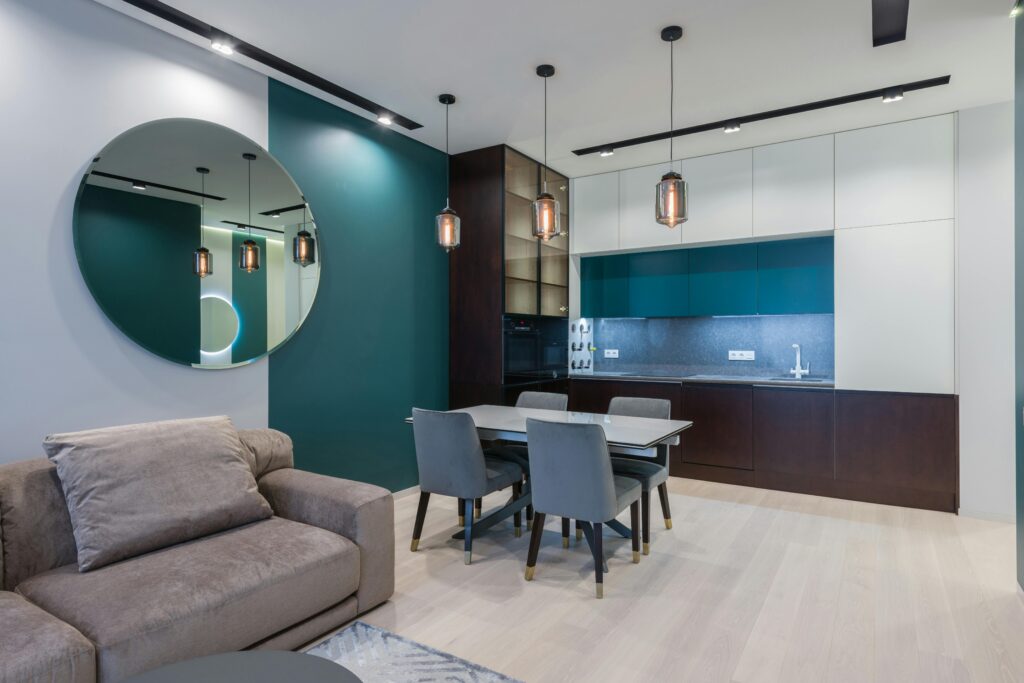
Overhead Lighting: Setting the Mood
Overhead lighting is the first layer of light that you’ll need for your kitchen. It sets the general tone for the entire space. This type of lighting is usually diffused and fills the entire room with ambient light. Overhead lights come in various styles, from simple ceiling-mounted fixtures to elaborate chandeliers.
- Types of Overhead Lighting
- Flush-Mount Ceiling Lights: These lights are mounted directly against the ceiling and are ideal for kitchens with low ceilings.
- Chandeliers for Kitchens: If you’re looking for something more decorative, chandeliers can make a bold statement while offering great light coverage.
- Track Lighting: For a more modern approach, track lighting provides adjustable light that can be directed to specific areas of the kitchen.
Incorporating Pendant Lights into Your Design
Pendant lights have a special place in kitchen design, especially when it comes to illuminating islands or dining areas. These lights come in a variety of shapes, sizes, and finishes, making them a versatile choice for different kitchen styles. Pendant lights not only serve as task lighting but also add a touch of elegance or personality to your space.
- Choosing the Right Pendant Lights
- Size and Placement: Make sure to choose the right size of pendant light. If you have a large kitchen island, a larger pendant or a grouping of pendants might be necessary. Smaller islands or breakfast bars could benefit from smaller pendant lights.
- Material and Finish: Pendant lights come in various materials, including glass, metal, and wood. Choose a material that complements your kitchen’s aesthetic.
The Charm of Chandeliers for Kitchens
Chandeliers are often associated with formal dining rooms, but they can also make a stunning addition to your kitchen. A chandelier above the dining table or kitchen island adds sophistication and drama. However, choosing the right chandelier is key to making sure it doesn’t overwhelm the space.
- Types of Chandeliers for Kitchens
- Traditional Chandeliers: These chandeliers often feature ornate details and multiple bulbs. They are perfect for larger, more traditional kitchens.
- Contemporary Chandeliers: For modern kitchens, consider a minimalist chandelier with clean lines and geometric shapes.
- Mini Chandeliers: If your kitchen is smaller, you can opt for a smaller chandelier that still provides ample light without overpowering the space.
Task Lighting: Focusing on What Matters
While ambient lighting sets the tone for your kitchen, task lighting is what ensures that your kitchen is functional. Whether you’re chopping vegetables, reading a recipe, or doing dishes, you need good lighting over your work areas. The goal is to provide bright, focused light without causing shadows or glare.
- Key Areas for Task Lighting
- Countertops: Under-cabinet lights or pendant lights above countertops provide bright, focused light where you need it most.
- Sink Area: A well-lit sink area is essential for washing dishes or prepping food. A pendant or track light can be a good solution.
- Stovetop: Installing a light directly above the stovetop ensures you can see your cooking clearly, whether you’re sautéing, simmering, or boiling.
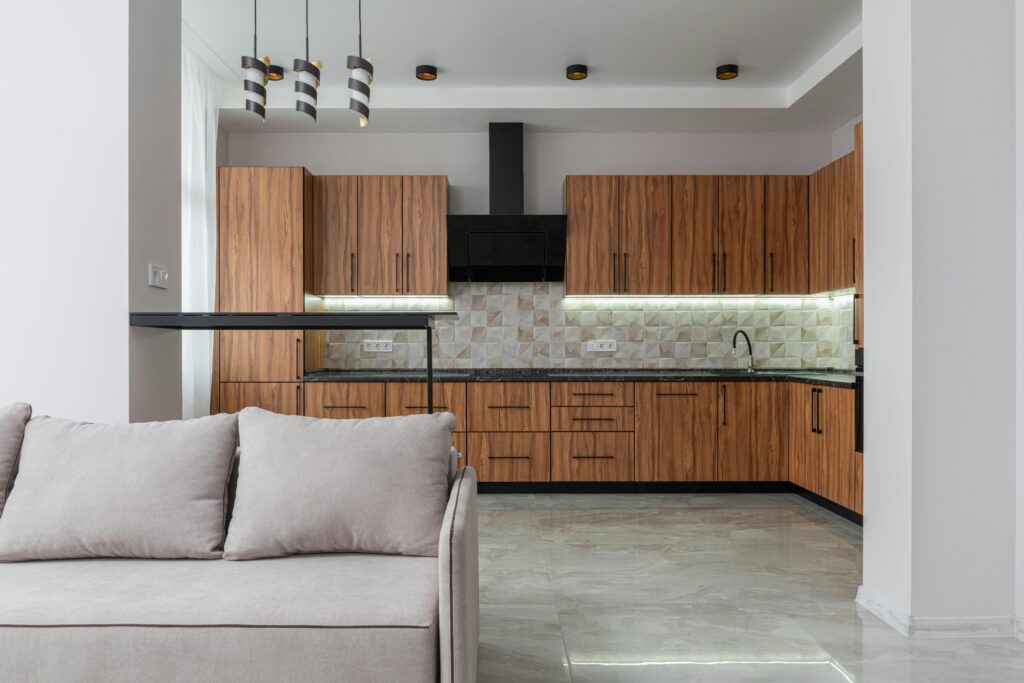
Recessed Lighting: The Sleek Solution
Recessed lighting is one of the most popular options for modern kitchens. These lights are built into the ceiling, which makes them a great choice for anyone who prefers a clean, minimalist look. Recessed lights provide even, unobtrusive lighting and are perfect for ambient lighting or task lighting when placed over work areas.
- How to Use Recessed Lighting
- Grid Pattern: For even lighting, recessed lights can be arranged in a grid pattern across the kitchen ceiling. This ensures that the entire kitchen is well-lit.
- Task Lighting: Install recessed lights directly above work areas, such as the sink or countertop, for focused task lighting.
- Accent Lighting: Recessed lights can also be used to highlight particular features, such as artwork, shelving, or a beautiful backsplash.
Under-Cabinet Lighting: The Unsung Hero
Under-cabinet lighting is often overlooked but is one of the most practical and effective lighting solutions for a kitchen. These lights are installed under your cabinets to provide focused light for countertops and workspaces. The best part? Under-cabinet lighting doesn’t take up any counter space, and it gives your kitchen a sleek, modern look.
- Types of Under-Cabinet Lighting
- LED Strips: These are flexible and easy to install, making them a popular choice for under-cabinet lighting.
- Puck Lights: These small, round lights are great for providing concentrated light over specific areas of the countertop.
Decorative Kitchen Lights: Style Meets Function
Lighting isn’t just about functionality—it’s also about creating ambiance and style. Decorative kitchen lights help to elevate the aesthetic of your kitchen while providing the necessary illumination. Whether it’s a statement chandelier or a sleek pendant light, decorative lighting can reflect your personal taste and complement the overall design of the space.
- Choosing Decorative Lights
- Chandeliers: As mentioned earlier, chandeliers aren’t just for dining rooms—they can be a stunning focal point in your kitchen. Choose a chandelier that fits with the overall theme of your kitchen—whether it’s vintage, modern, or industrial.
- Cluster Pendant Lights: Grouping multiple pendant lights together can create a striking visual effect. They can be hung at varying heights above a kitchen island or dining table to add drama and elegance.
- Lantern-Style Lights: For a rustic or farmhouse-style kitchen, consider lantern-style pendant lights. These lights offer a charming, timeless look.
Smart Kitchen Lighting: The Future is Now
As technology advances, so does the way we interact with our lighting. Smart kitchen lighting allows you to control your lights using your voice, a smartphone app, or automated schedules. Imagine adjusting the lighting in your kitchen while you’re cooking or dimming the lights for a cozy dinner—all with just a few taps on your phone or voice commands.
- Benefits of Smart Lighting
- Convenience: Control your lights from anywhere using an app or voice assistant (like Alexa or Google Assistant).
- Energy Efficiency: Set schedules for your lights to turn off when not in use, reducing energy consumption.
- Customization: Choose from a variety of color temperatures and brightness levels to create the perfect ambiance for any occasion.
- Popular Smart Lighting Options
- Philips Hue: One of the most well-known smart lighting systems, offering a wide range of bulbs and light strips that can be customized to fit your kitchen’s needs.
- LIFX: These smart bulbs don’t require a hub and are available in a range of colors and brightness levels, making them ideal for kitchens.
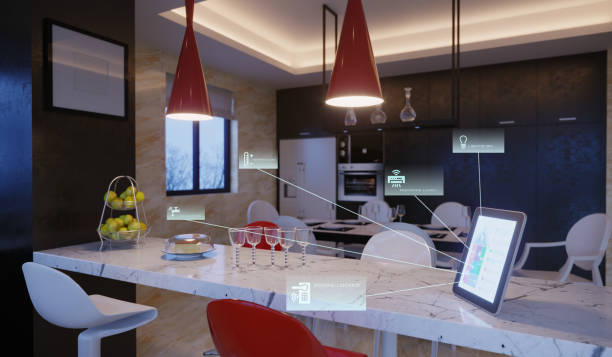
How to Install Kitchen Light Fixtures
Installing kitchen light fixtures might sound like a daunting task, but it’s actually something you can do yourself if you follow the right steps. Here’s a simple guide to installing your kitchen lights.
- Step 1: Turn Off Power Before you begin, make sure the power to your kitchen is turned off at the breaker box to avoid any accidents.
- Step 2: Choose Your Fixtures Decide on the type of light fixture you want to install. Ensure that it’s compatible with your kitchen’s layout and electrical setup.
- Step 3: Install the Mounting Bracket For ceiling lights or chandeliers, you’ll need to install a mounting bracket. This bracket will hold the fixture in place. Follow the manufacturer’s instructions carefully.
- Step 4: Connect the Wires Connect the electrical wires from the fixture to the existing wires in your ceiling. Use wire nuts to secure the connections and make sure the wires are properly insulated.
- Step 5: Attach the Fixture Once the wiring is complete, attach the light fixture to the mounting bracket. Be sure the fixture is securely fastened.
- Step 6: Test Your Lights Once everything is in place, turn the power back on and test your new lights. Make sure all the bulbs are working, and adjust the positioning of any fixtures if needed.
Maintenance Tips for Kitchen Light Fixtures
Your kitchen light fixtures not only need to be properly installed, but they also need to be maintained to ensure they last for years to come. Regular cleaning and occasional bulb replacements will keep your kitchen lighting in top condition.
- Cleaning Your Fixtures
- Ceiling Lights and Chandeliers: Dust can accumulate on light fixtures, especially in a busy kitchen. Clean them regularly with a soft cloth and mild detergent to avoid buildup.
- LED Lights: LED lights typically require less maintenance, but you should check them periodically to ensure they’re functioning properly.
- Replacing Bulbs
- LED Bulbs: These bulbs last much longer than traditional bulbs, but when they do burn out, they should be replaced with an LED of the same wattage to maintain the right brightness.
- Incandescent or Fluorescent Bulbs: If you’re still using these types of bulbs, be sure to replace them as soon as they stop working to prevent uneven lighting in your kitchen.
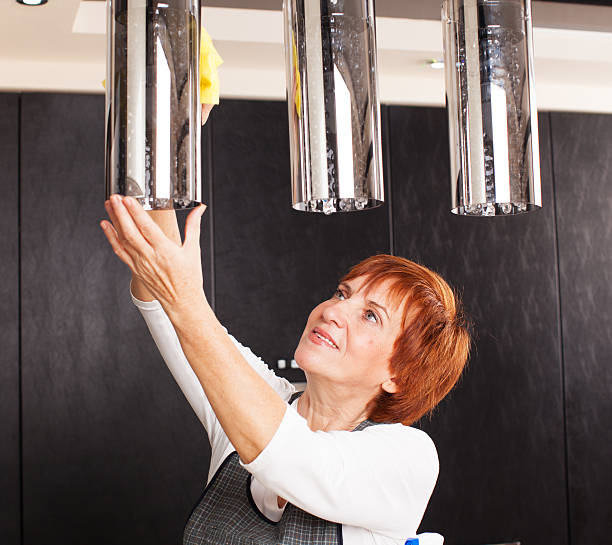
The Cost of Kitchen Lighting Fixtures
The cost of kitchen light fixtures can vary depending on the style, brand, and type of lighting you choose. While it’s possible to find budget-friendly options, investing in high-quality fixtures can make a big difference in both function and aesthetics. Here’s a breakdown of the average costs for different types of fixtures:
- Ceiling Lights: Basic ceiling lights can cost anywhere from $20 to $100, depending on the design.
- Pendant Lights: These can range from $30 to $200 or more, depending on size, material, and style.
- Chandeliers: Chandeliers can range from $50 to over $500, with luxury options costing even more.
- LED Lighting: LED bulbs or strips typically range from $10 to $50 per bulb or strip, depending on the quality and brand.
Author Remarks
Choosing the right kitchen light fixtures can completely transform your kitchen. Whether you prefer sleek modern fixtures, rustic charm, or classic elegance, there are endless options to suit every style and budget. Remember, the key is to balance functionality with aesthetics—after all, you want your kitchen to be both a practical space and a beautiful one.
By understanding the different types of kitchen lighting, considering the size and layout of your kitchen, and choosing fixtures that match your personal style, you can create a space that’s not only well-lit but also welcoming and stylish. So, get ready to illuminate your kitchen in the best way possible and make every meal preparation a bright and beautiful experience!

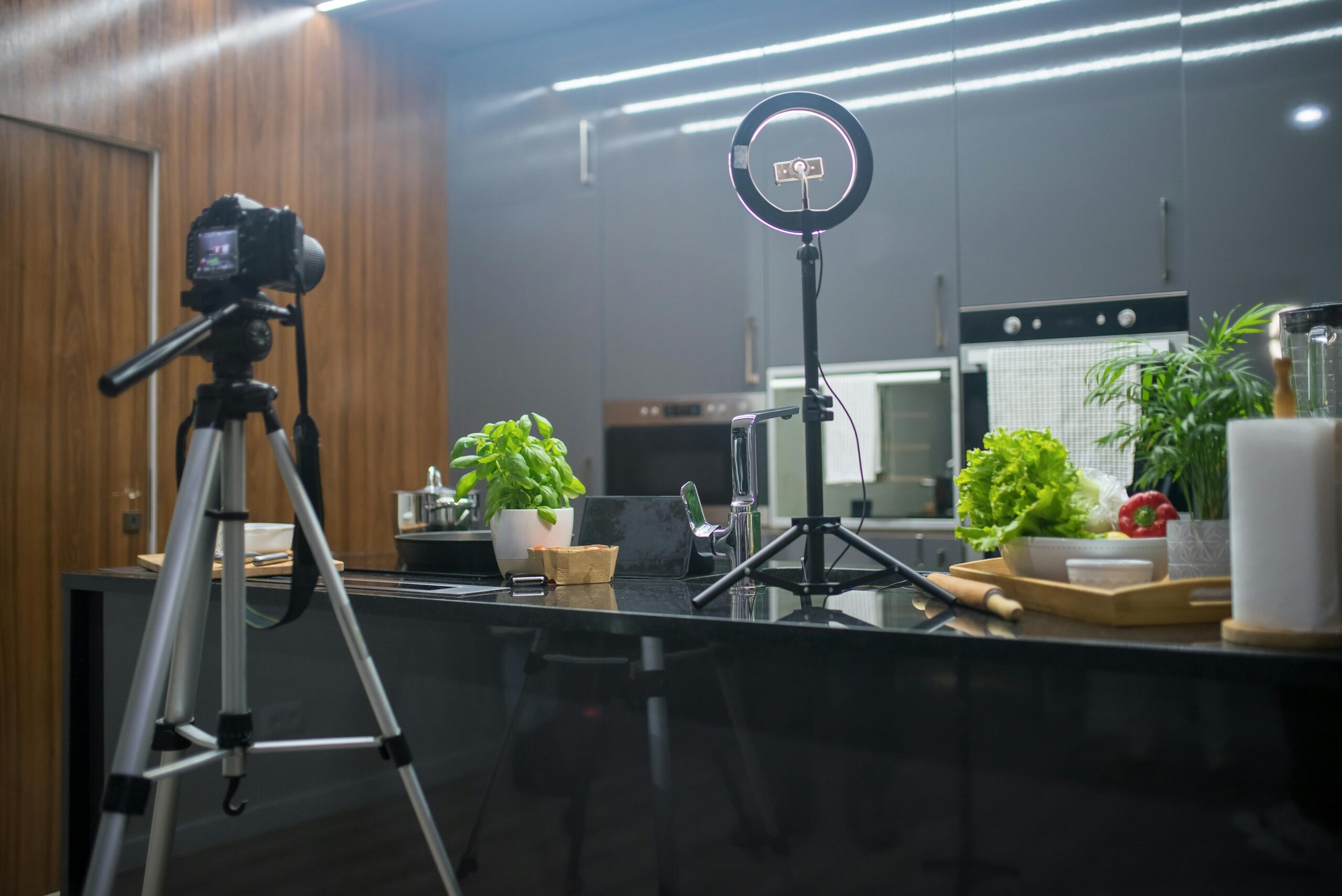
6 Comments